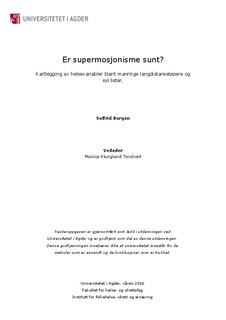| dc.description.abstract | Introduction: Physical activity is well documented as an important factor for good health.
There are however some people who train far beyond the national recommendations for
6
physical activity combined with work and family life. The research done on «high volume
exercisers» is limited, specially the health variables.
Objective: The purpose with this master paper is to investigate if high volume exercise is
healthy. By identifying different health variable it may point to how the body responds to
high training volume.
Method: 41 male high volume exercises (18 to 50 years) were included in this cross-sectional
study. The compilation of data was gathered during two phases: Spring 2015 (cyclists n=21)
and autumn 2015 (long-distance runners n=20) in Kristiansand Commune. The study utilized
a questionnaire (LEAM-Q, ” Energy Availability, sport and performance”, ”The Exercise
Dependence Scale (EDS)) and also objective measuring methods (DXA, Canopy-opsjon for
Oxycon Pro)
Results: The main findings in this study shows that the participants are within the area of
reference when it comes to blood pressure, cortisol, testosterone, triglycerides, glucose and
insulin. During this time there were registered six (14,6%) cases with osteopenia and ten
(24,3%) cases with the risk of exercise addiction.
Conclusion: In general high volume exercisers have good health, but there are some risks
with high volume exercise. One important factor to take in to consideration are the individual
differences. It is important to listen to the body’s signals and recover after long high volume
exercises. The high volume exercisers do not differ negatively from the general population.
Keywords: Public health, exercise addiction, hormones, diseases, endurance athletes, bone
mineral density | nb_NO |
